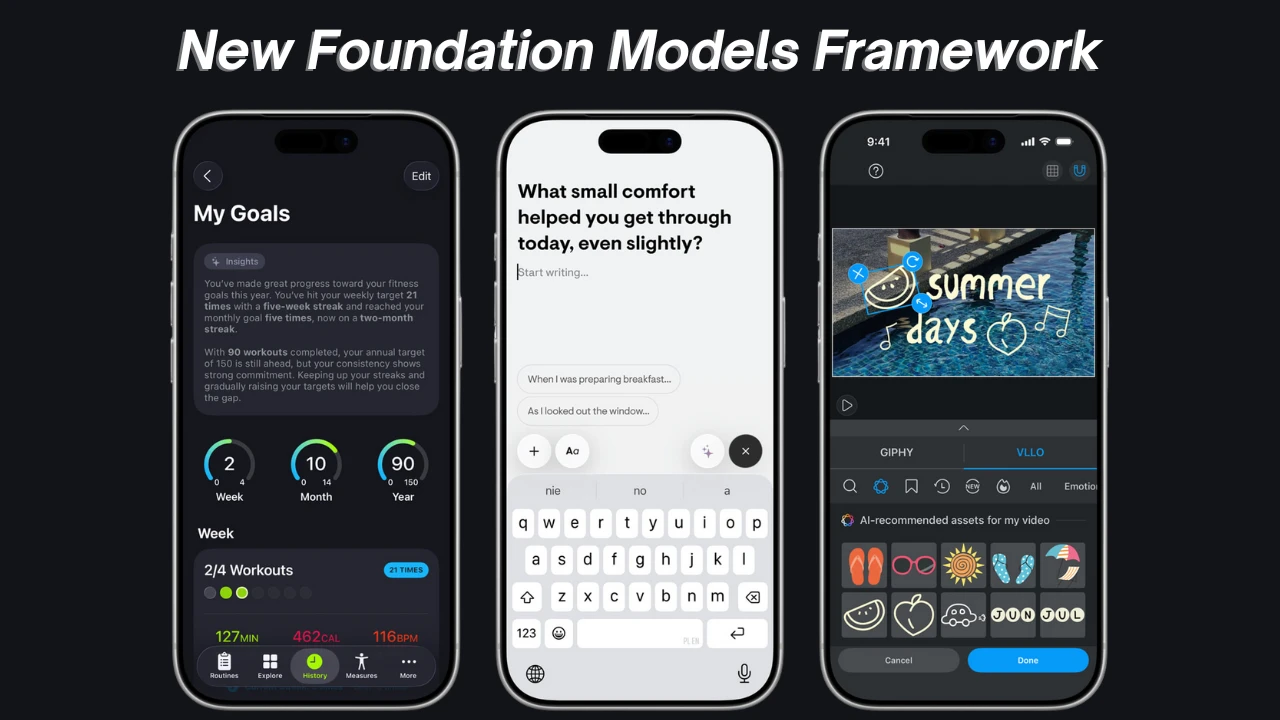Recently, Apple has made a big announcement in its Newsroom update. Today, we are going to know about it in detail in this report. Let us tell you that the company has introduced a new Foundation Models Framework, which will make the apps coming on iOS 26, iPadOS 26, and macOS 26 even smarter. Apart from this, Apple says that this framework gives developers direct access to Apple Intelligence’s on-device large language model. This means that now the apps will be able to run AI features on the device itself, without depending on the internet or cloud. Due to this, now users will also get a fast and private experience. So, let us first know about the Apple Foundation Models Framework in short.
What Is Apple’s Foundation Models Framework?
Apple’s Foundation Models Framework is a new developer tool that’s part of the company’s Apple Intelligence strategy. It aims to bring the power of on-device Large Language Models directly to macOS apps. This framework allows developers to add smart and personalized AI features to their apps using the Swift API.
The most significant feature of the Apple Foundation Models Framework is that the model runs entirely on-device, meaning there’s no reliance on the internet or cloud servers. This not only makes processing extremely fast and real-time, but also ensures user data is completely secure. The framework includes a 3 billion-parameter on-device model, which will be available on iOS 26, iPadOS 26, and macOS 26, and will only run on devices that support Apple Intelligence.
What Changes Will the Framework Bring?
The introduction of Apple’s Foundation Models Framework is set to transform the way we use apps. Developers will now be able to directly leverage Apple Intelligence’s on-device large language models (LLMs) to make their apps smarter. The biggest change is that apps will no longer need to rely on the internet or cloud servers to function. This means features will operate faster and in real-time, while user data will remain completely secure and private.
Fitness apps will now be able to create personalized workouts from user health data, note apps will be able to instantly convert voice and handwritten input to text, and video editing and creative apps will offer smart suggestions with AI. Tasks that previously required heavy servers and backend infrastructure can now be performed directly on devices like iPhone, iPad, and Mac. This update not only provides developers with simple and cost-effective tools but also ensures a fast, secure, and personalized user experience.
Benefits for Developers

Apple’s new Foundation Models Framework brings several significant benefits to developers. Previously, adding AI-enabled features to an app required developers to rely on backend servers, expensive GPU clusters, and cloud infrastructure, which increased costs and posed challenges to user data security. However, with this framework, developers can now use large language models directly on-device.
This means developers will be able to add smart features to apps even without an internet connection, resulting in faster and more reliable performance. Furthermore, developers will no longer need to build separate server infrastructure, significantly reducing costs. Because it operates entirely on-device, user data will always be secure and private. Overall, this framework will prove to be not only a simpler but also a more secure and cost-effective solution for developers.
Apps Already Using the Framework
Apple said that many popular apps have already started using this framework.
| App | New AI feature |
|---|---|
| SmartGym | Creating personalized workout plans, training tips, and reports from user data. |
| Stoic | Delivering automatic journaling prompts and motivational content based on your mood. |
| CellWalk | Explaining complex science topics to students in simple language and conversational style. |
| Stuff | Create tasks by voice (Listen Mode) and convert handwritten notes to text. |
| VLLO | Suggesting music and stickers with the help of AI during video editing. |
These examples make it clear that the Apple Foundation Models Framework is going to be useful everywhere, from productivity apps to creative tools and health platforms.
How It Will Impact Users’ Lives
Apple’s Foundation Models Framework is set to bring many changes to users’ lives. The most significant feature is that apps will now use on-device AI to deliver smarter and more personalized experiences. For example, fitness apps will analyze your workout and health data to provide personalized recommendations, while journaling apps will offer automatic prompts and motivational content tailored to your mood. Additionally, video or creative apps will provide music, stickers, or editing suggestions that best suit your content.
Video Source: Apple
Because this AI runs directly on the device, processing will be faster, and user data will remain completely secure and private. This means users will experience a new, smarter, and more reliable digital experience, allowing them to fully leverage AI-enabled features on their devices without the need for cloud or internet access.
Apple’s Strategy and Developer Focus
The introduction of the Apple Foundation Models Framework is a major relief for developers, as they no longer have to rely on expensive backend servers or the cloud to deliver AI features. Apple’s strategy is clear: it wants to move its entire ecosystem towards on-device AI. The benefit of this will be that iPhone, iPad, and Mac users will no longer be limited to productivity or entertainment, but will experience a powerful AI assistant.
SEE ALSO: M5 vs M4 Chips: What Will Be the Difference in CPU, GPU, AI, and Battery Benchmarks?
Final Thoughts
Apple’s Foundation Models Framework is a significant step forward for on-device AI, delivering faster, smarter, and more secure app experiences. I personally love Apple’s Foundation Models Framework, and I hope other developers will too, as it reduces cost and complexity for developers, while providing improved privacy, speed, and personalization for users. It’s poised to transform the way apps interact with users and redefine the future of AI on Apple devices.
SEE ALSO: Report Get Ready: Apple’s M5 MacBook Air, Pro, and 27-inch Monitor Are Coming


